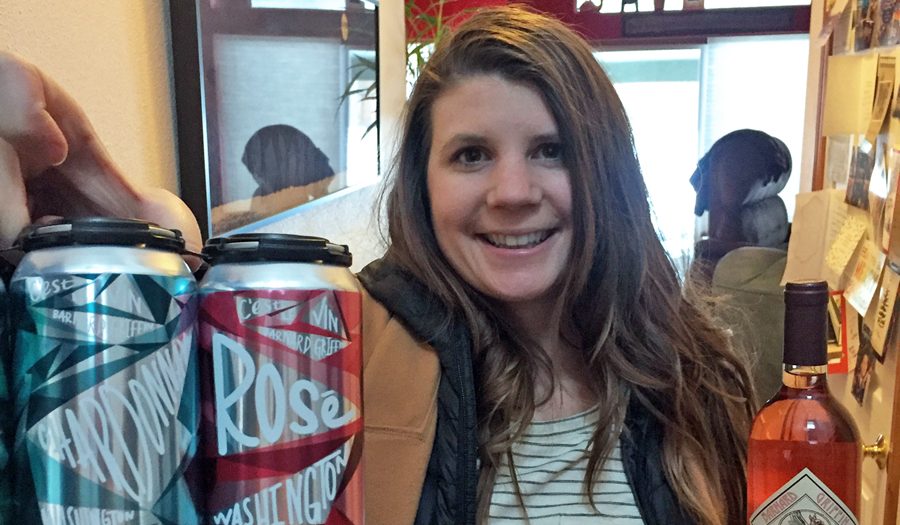
Home » Wineries try six-pack approach to reach younger wine drinkers
Wineries try six-pack approach to reach younger wine drinkers

March 13, 2019
By Andy Perdue
More than any
winery in Washington, Richland’s Barnard Griffin has a well-earned reputation
as a leader in the Northwest’s burgeoning rosé wine market.
Now the
longtime winery is testing a new kind of innovative packaging: putting wine in
an aluminum can.
Along the West
Coast and in the Northwest, more wineries are putting wine in cans, partially
in an effort to reach a younger demographic of wine drinkers, as well as for
consumer convenience. According to a recent Gallup poll, as many Americans
prefer wine to beer as their choice of adult beverage, so a move to a can,
which takes no special tool or skill to open, makes greater sense. Retailers
are beginning to put canned wine in the beer aisle, which delights winery
owners who look for ways to penetrate that demographic.
Barnard
Griffin made 16,000 cases of rosé from the 2018 vintage, and is putting the
equivalent of 4,000 cases in cans. Each can holds 12 ounces — equivalent to a
half-bottle of wine (a standard wine bottle is 750 milliliters, or 25 ounces).
The canned version probably will retail for $6.99, while a bottle will cost $14
The winery
also put some of its Chardonnay and Sauvignon Blanc in cans. The canned
versions of the wines will be in distribution only, including grocery and
specialty stores, rather than at the winery.
In January, Barnard Griffin’s 2018
Rosé of Sangiovese won a unanimous double gold medal at the San Francisco
Chronicle Wine Competition in California’s Sonoma County. The wine has won a
gold medal or better 13 times in 14 years at the largest judging in America.
The wine that goes into cans is identical to what is in the bottle, said assistant winemaker Megan Hughes, daughter of founders Rob Griffin and Deborah Barnard.
Hughes, 30,
sees the new package as a way to appeal to younger wine drinkers.
“We’re aware
that it’s millennials who mainly are buying cans, but honestly, cans are a good
package for a lot of different people,” Hughes said. “Some people like the fact
that it’s recyclable. A lot of other people enjoy that when they go out with
their buddies that you can have a serving of wine while everybody else is
drinking a different thing, whether it’s a cocktail or a beer.”
Cans work well
in many situations. It’s easy to throw a few cans of wine into a cooler. It
takes no special tool (such as a corkscrew) to open, you don’t have to worry
about a glass bottle.
Barnard
Griffin is not alone in jumping into canned wine. Goose Ridge Vineyards in
Richland has two canned wines under its Cascadian Outfitters label. Milbrandt
Vineyards, which used a Cabernet Sauvignon to make Wine Spectator’s Top 100
list for 2018, recently unveiled three canned wines.
Precept Wines
in Seattle (the state’s second-largest wine producer) has cans for its House
Wine label. In July, it’s releasing three wines from Waterbrook Winery in Walla
Walla. And two of its Idaho wineries, Ste. Chapelle and Sawtooth, will have
wines coming out in cans.
In Sherwood,
Oregon, Union Wine Co. has been at the forefront of the Northwest canned wine
movement under its Underwood label. Newcomers include Stoller Wine Group in
Dayton with its Canned Oregon and Dobbes Family Estate’s Joe To Go in Dundee.
Ron Penner-Ash is part of the
Portland-based group behind Free Public Wines, and those wines are canned in
Prosser by Four Feathers Wine Estates.
Because
consumers are seeing canned wines from California and elsewhere from the world
of wine, Barnard Griffin seems to be a fit for the canned wine scene.
Pink and white
wines are perfect styles for cans. They are meant to be consumed quickly versus
aging. A can of wine also is easy to chill on ice while grilling food under the
Columbia Valley summer skies.
Barnard
Griffin produces 20 wines in addition to its reserve tier, but Hughes said
don’t expect any of their red wines to go into cans anytime soon.
“I don’t think
we’re going to do any red wines in cans,” Hughes said. “It’s a fast-moving
market that seems geared toward white wine drinkers. But we’re open to
anything, so never say never.”
The process of getting the three
wines into cans took about a year after she pitched the idea to her dad, who
has been making Washington wine for 43 years since coming to the Tri-Cities
from his native California in the mid-70s.
“We’ve put wine in glass for a
number of years with our own equipment and knowing all of the variables,”
Hughes said. “But this is a totally new package launch, so we brought somebody
in and he had all of the equipment that allowed us to put it in the can.”
They contracted with a company
called Tinman Mobile Canning based in Clackamas, Oregon.
• • •
Wine Press Northwest magazine in Kennewick has named Palencia Wine Co. its 2019 Pacific Northwest Winery of the Year. Owner Victor Palencia operates Palencia and his Vino la Monarcha brands out of downtown Kennewick.
• • •
The Washington Winegrowers
Association handed out the following awards at its annual convention in
February: Lifetime Achievement Award: Ted Baseler, retired CEO of Ste. Michelle
Wine Estates; Industry Service Award to Rick Hamman of Hogue Ranches; Grand Vin
Award to Charlie Hoppes of Fidelitas Wines on Red Mountain; Grower of the Year
went to Jim McFerran of Wahluke Wine Co. in Mattawa.
• • •
Milbrandt Vineyards was named Wine
Press Northwest magazine’s 2019 Washington Winery of the Year. Butch Milbrandt
and his son, Buck, operate tasting rooms in Prosser, Woodinville and
Leavenworth.
Andy Perdue, editor and publisher of Great Northwest Wine and founding editor of Wine Press Northwest magazine, is the wine columnist for The Seattle Times.
Local News
KEYWORDS march 2019





